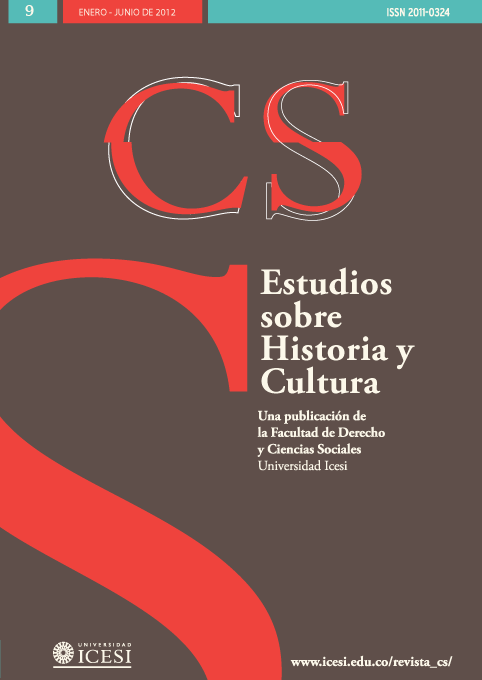Medidas abolicionistas em Nueva Granada, 1814–1851
DOI:
https://doi.org/10.18046/recs.i9.1221Palavras-chave:
Legislação abolicionista, a Escravidão, Descent Africano, Nova GranadaResumo
No presente artigo, enfatizamos na analise das narrativas das diferentes medidas abolicionistas e alguns de seus efeitos na problemática da escravatura. Nosso argumento é que, na analise das medidas abolicionistas, a contradição entre manter em escravidão a uma parte da população e o discurso independentista se evidencia desde muito cedo. Mas, na prática, estas medidas estiveram focadas menos em produzir os cidadãos como em garantir aos escravos suas ''indenizações'' e em minar mediante vigilâncias individuais e dispositivos de controle como el concertaje, que os libertos se somaram submissamente a um estado de distribuição da riqueza e do prestigio que os mantinham nas margens.
Downloads
Referências
Castellanos, J. (1980). La abolicion de la esclavitud en Popayán 1832–1852. Cali: Univalle.
Chakrabarty, D. (2008). Al margen de Europa ¿Estamos ante el final del predominio cultural europeo? Barcelona: TusQuets Editores.
Chatterjee, P. (2008). ''Comunidad imaginada ¿por quién?''. La nación en tiempo heterogéneo y otros estudios subalternos. Buenos Aires: Siglo XXI–Clacso, pp. 89–106.
Foucault, M. (1999). ''Polémica, política y problematizaciones''. Estética, ética y hermenéutica. Obras Esenciales. Barcelona: Paidós. pp. 353–361.
Foucault, M. (1988). ''On problematization''. The History of the Present, 4, pp. 16–17.
González, M. (2005). Ensayos de historia colonial colombiana. Bogotá: Nomos.
Mosquera, J. (1825). Memoria sobre la necesidad de reformar la ley del congreso constituyente de Colombia de 21 de julio de 1821, que sanciona la libertad de los partos, manumision y abolicion del trafico de esclavos y bases que podrian adoptarse para la reforma. Bogotá: Impreso por F. M. Stokes. Localización: Archivo General de la Nación. Sección: Academia Colombiana de Historia. Colección de documentos varios. Caja 5, Carpeta 7.
Mosquera, S. (2004). Gente negra en la legislación colonial. Medellín: Editorial Lealón.
Múnera, A. (1998). El fracaso de la nación: región, clase y raza en el Caribe colombiano (1717–1821). Bogotá: Ancora.
Restrepo Canal, C. (1933). Leyes de manumisión. Bogotá: Imprenta Nacional.
Restrepo Canal, C. (1938). La libertad de los esclavos. Leyes de manumisión. Vol. II. Bogotá: Imprenta Nacional.
Restrepo, J. F. de (1935). ''Discurso sobre la manumisión de esclavos, pronunciado en el Soberano Congreso de Colombia reunido en al Villa del Rosario de Cúcuta en el Año de 1821.'' En Guillermo Hernandez de Alba, Vida y escritos del doctor Félix de Restrepo. Bogotá: Imprenta Nacional, pp. 82–128.
Valencia, A. (1998). ''La guerra de 1851 en el Cauca''. Las guerras civiles desde 1830 y su proyección en el siglo XX. Bogotá: Museo Nacional de Colombia pp. 37–58.
Zuluaga, F. (1998). ''La Guerra de los Supremos en el suroccidente de la Nueva Granada''. Las guerras civiles desde 1830 y su proyección en el siglo XX. Bogotá: Museo Nacional de Colombia, pp. 17–36.
Downloads
Publicado
Edição
Seção
Licença
Copyright (c) 2012 Eduardo Restrepo

Este trabalho está licenciado sob uma licença Creative Commons Attribution-NonCommercial 4.0 International License.
© Direitos autorais reservados
O material desta publicação pode ser reproduzido sem autorização, desde que o título, o autor e a fonte institucional sejam citados.
O conteúdo publicado na Revista CS é distribuído sob a licença Creative Commons BY-NC 4.0 Attribution/Attribution-NonCommercial 4.0 International.
Você tem o direito de:
Compartilhar — copiar e redistribuir o material em qualquer suporte ou formato.
Adaptar — remixar, transformar, e criar a partir do material.
De acordo com os termos seguintes:
Atribuição — Você deve dar o crédito apropriado , prover um link para a licença e indicar se mudanças foram feitas . Você deve fazê-lo em qualquer circunstância razoável, mas de nenhuma maneira que sugira que o licenciante apoia você ou o seu uso.
NãoComercial — Você não pode usar o material para fins comerciais.











